10 Tips for Going Solar: The Dos and Don’ts
Informed buyers always have the upper hand
- Avoid getting ripped off
- Know what questions to ask
- Find the right installer
Last Updated: 8th Apr 2025
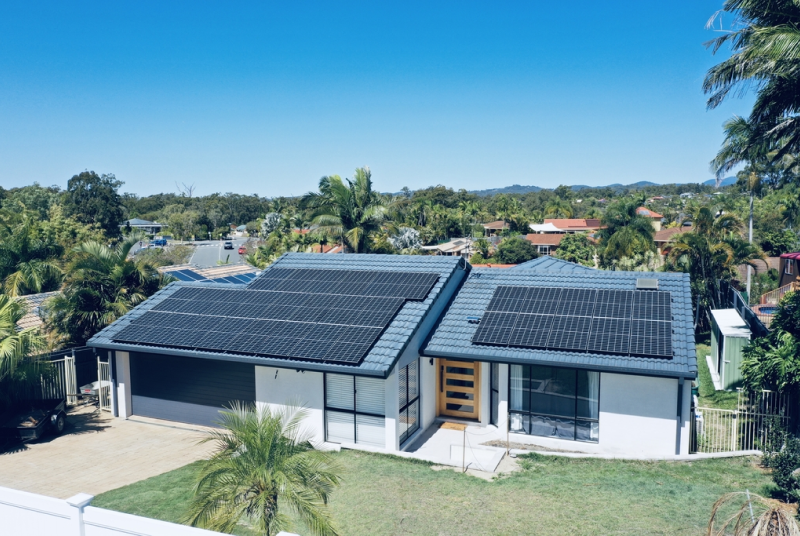
I’ve been in the solar world for 15 years, have answered literally tens of thousands of customer questions, and provided quotes for solar to over 780,000 Australians through this website, SolarQuotes.
With all of the knowledge I’ve gained over that time, I’ve distilled it all into the following article: My “dos and don’ts” of going solar:
Dos
1) Do get at least two, if not three, quotes.
I swear this isn’t a shameless plug for the free service my website provides. It’s absolutely critical to get multiple quotes wherever possible (and not just when it comes to solar!).
By having multiple companies give you a breakdown of what solar will cost you, you can gain a real understanding of whether solar is right for your budget and whether or not you’re being ripped off (in either price or quality).
It’s not uncommon to see unscrupulous installers charging $15,000 for a system worth $6,000!
2) Do buy solar panel or inverter brands from these charts
I’ve put together the following two charts to show all the panel and inverter brands passing my “grandmother rule” test.
Which is “If I wouldn’t recommend a brand to my grandmother, I won’t recommend it to you”.
One thing to clarify – I’m not saying that if you buy a brand that isn’t listed here, you’ll be getting crap.
What I am saying is – for a brand to get onto my trusted charts, I have to be extremely confident that they are, in fact, good.
There are over 14 brands of panels and over 10 brands of inverters I can recommend, covering all ends of a budget.
So why roll the dice on one that’s not on there?
First up – solar panel brands that I’m happy to recommend:
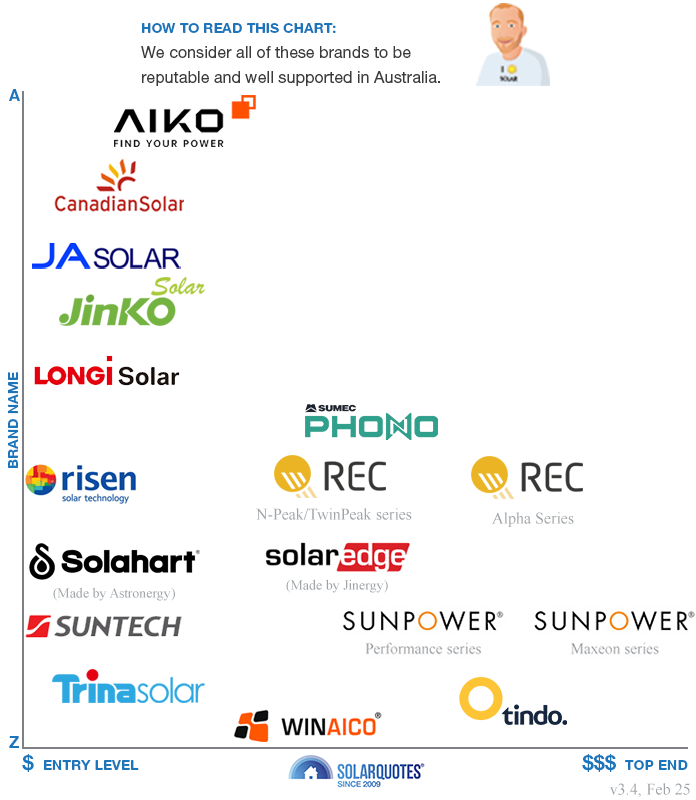
Secondly – solar inverter brands that I’m happy to recommend:
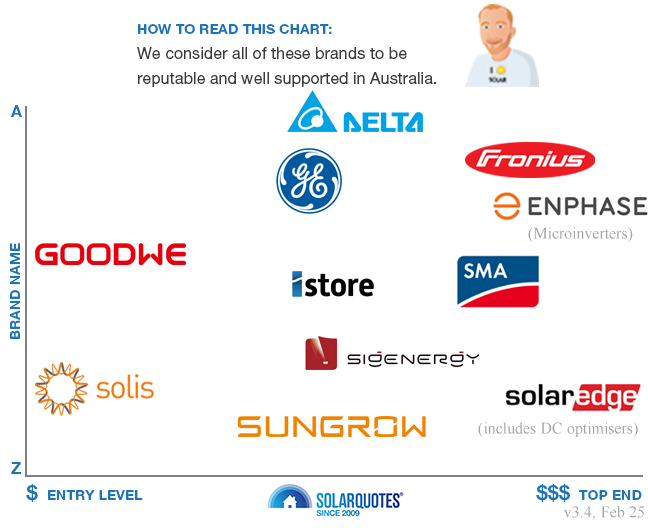
3) Do understand the difference between the “solar rebate” and the “feed-in tariff”
People get these mixed up all the time. To keep it simple:
The ‘solar rebate’ acts as a point-of-sale discount off the cost of a solar system and is claimed on your behalf by your solar installer.
The ‘feed-in tariff’ is what your electricity retailer pays you per kWh for feeding excess solar into the grid. Retailers can pay anywhere from 0-12c per kWh.
If you see prices quoted online, on the telly, or in the paper, there’s a 99.99% chance that the price already has the ‘discount’ from the solar rebate applied.
It’s worth about $350 per kW of solar panels installed, but this will vary depending on where you live.
As an example, a 6.6kW system attracts around $2,300 in rebates.
Anyone can claim the rebate, even if you’ve already bought solar power systems in the past and want to buy a new system.
4) Do shop around for your energy retailer
If you’re in WA you can skip this one – as you don’t have any energy retailer competition!
Whether you have solar or not, chances are high that you’re not on the best energy plan for your home.
Add solar into the mix, which sells excess generation into the grid, and you are even less likely to be on the optimal plan.
Being on the wrong plan can cost you hundreds of dollars per quarter.
Especially when retailers can pay anywhere between zero and 12c per kWh as a feed-in tariff!
My advice – put on solar. Enjoy the savings for a full quarter. Then use your first solar bill and a good online tool – like mine – to work out which retailer will give you a balance of high feed-in and low usage tariff to get that bill even lower.
5) Do put on as much solar as your roof and budget can handle
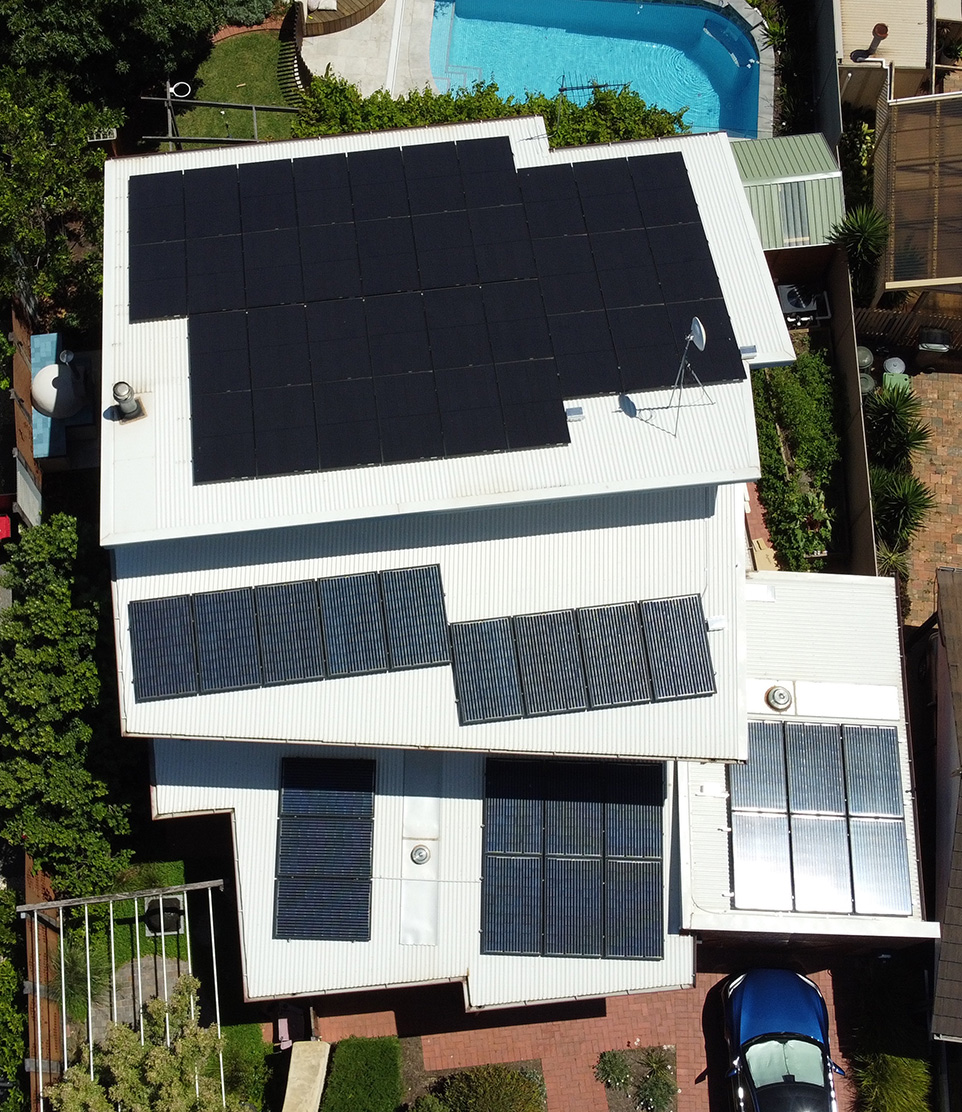
20kW of solar on my house – I practice what I preach!
“How many solar panels should I get?” I hear this question all the time!
My go-to answer is: Install as many solar panels as you can comfortably fit and afford.
The number of panels you can install depends on a few factors, like the space on your roof and the rules set by your local electricity network. A smart installer is worth their weight in gold here, as they’ll work with the rules to get you the most solar possible.
I’ve never heard anyone say they wish they’d gotten a smaller solar system. But I do hear from people all the time who wish they’d installed more panels when they had the chance. Adding panels later can be costly and tricky – or sometimes outright impossible.
Even if you think you ‘don’t need’ a bigger solar system right now, you’ll be glad you have one in the future if and when you get a battery or an electric car. If you go with a smaller system, you’ll probably be frustrated with its lower output, especially when winter rolls around.
If you’re looking to get quotes for solar from installers within our trusted network, that are looking out for your needs (and not just over their own wallet) then simply
Don’ts
1) Don’t wait for batteries to drop in price before going solar
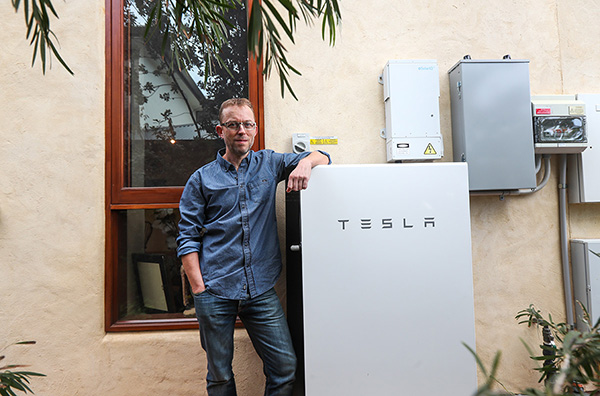
Me, posing with my Tesla Powerwall
Unfortunately, all the hype in the mainstream media about batteries has made people question the viability of solar without batteries – to the extent that people are waiting for ‘affordable batteries’ before they invest in solar.
Don’t get me wrong – with the right installer using certain brands, it is possible to get a great deal on a solar and battery system when you buy them in one hit.
If you can get such a deal – go for it. But if you can’t – or if they’re still outside your budget – my advice remains ‘don’t wait to put on solar’.
Every day you don’t have solar is another day you have to pay high electricity bills. A well-designed solar system without batteries can give you tiny bills.
Waiting 2, 3 or 4 years for batteries to become more affordable means another 2, 3 or 4 years of high bills.
One day, batteries will be a no-brainer – and when that day comes they can be added to any existing solar system.
So consider going solar now – don’t lose years of savings waiting for cheaper batteries to become mainstream.
2) Don’t go for the cheapest quote you can find
The best deal is rarely the cheapest deal. This is something we all understand intuitively.
So why are we so easily seduced by unbelievably cheap solar deals that appear so totally believable?
Let me be totally upfront with you – I did not set up this website, SolarQuotes, as a tool for people to find the absolute cheapest solar power systems on the market.
If you want the cheapest solar systems on the market, just type ‘cheap solar’ into Google and click on the Google Ad that promises a 6.6kW system for $3,000 (At time of writing, a quality 6.6kW installation will cost approx $5,000-$9,000). It really is that simple.
On the other hand, if you use my service, you should get great deals on quality hardware installed with care. The prices will be competitive because the installers are competing with their peers, but I want to be transparent with you. You’ll almost always be able to find a cheaper solar system elsewhere.
Many of the companies that advertise these ‘too good to be true’ deals have approached me asking to join the SolarQuotes network. I turn them down.
I don’t do this because I am trying to manipulate the market or keep great deals away from my visitors.
I do this because I have run SolarQuotes since 2009 with a very simple philosophy: If I would not recommend a company to my grandmother, I will not recommend them through SolarQuotes.
You see, while the front-end purchase may be cheaper with these systems, the Chartered Electrical Engineer in me knows that the long-term consequences of buying these stupid-cheap systems are that they end up being more expensive to the buyer in the long run.
As the old saying goes: “The bitterness of poor quality remains long after the sweetness of low price is forgotten.”
3) Don’t buy from a door-knocker or a cold-caller without extreme caution (at least get other quotes)
I don’t mean to insult an entire field of marketing here – but after 15 years running SolarQuotes, I’m yet to see someone get a better deal from a doorknocker or cold caller than they would have gotten if they shopped around and compared multiple quotes.
Sales companies that employ doorknockers or cold-call are prolific, so I get a lot of questions about the companies themselves, or the ‘deals’ they’re offering.
And these questions usually start with something like “I’ve signed a contract with a company that door-knocked me, and it just doesn’t feel right…“
When asked about these deals, my advice is always the same: At the very least, seek quotes for comparison, as you can always go back to what they’re offering later (despite what they might tell you!)
4) Don’t give up on solar just because you don’t have the ideal roof
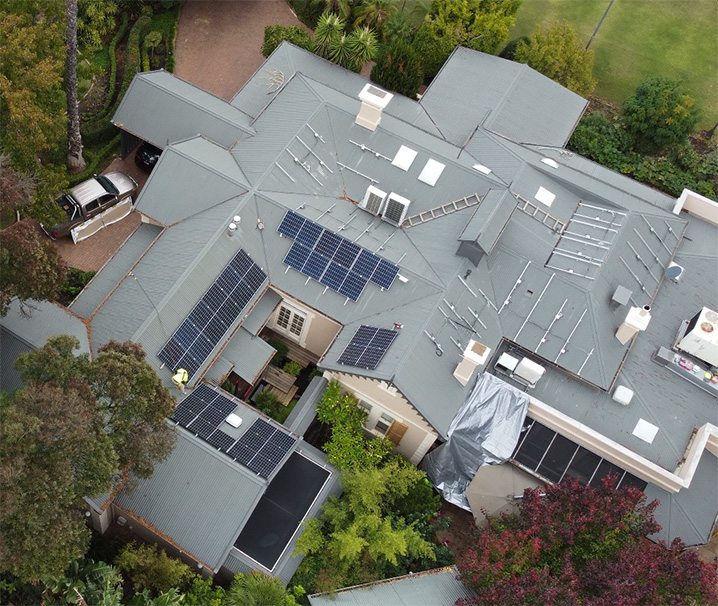
This is one tough roof – and yet panels are still facing every direction
Let’s look at the facts:
Solar panels peak in power production around midday.
North-facing panels will provide the most energy overall.
East-facing panels will produce more in the morning than north-facing. West-facing panels will maximise energy in the late afternoon.
This means a working household can self-consume more solar energy with east and west-facing panels, because they give more energy before and after school/work, accelerating their system’s payback.
Sadly, I’ve spoken to more than one homeowner with a massive east or west roof ripe for solar that thinks it just isn’t worth it if their panels can’t face north.
It used to be true that if you couldn’t install panels on a north-facing roof, then a solar power system wasn’t worth it.
Now that prices of solar power systems have dropped so much (around 80% over the last 9 years in Australia), you can get a fantastic return on investment from east-facing panels, west-facing panels, or a combination of north, east and west.
In some cases, it can even make sense to have south-facing panels – though this would be a last resort.
5) Don’t use expensive “no interest” finance deals
If you see a finance deal claiming ‘no interest’, the devil is in the details.
Some state governments—such as Victoria—offer genuine, taxpayer-subsidised, no-interest finance for part of the purchase price. For example, in VIC, the interest-free solar loan is only $1,400.
Otherwise, the solar installer has partnered with a “Buy Now Pay Later” (BNPL) company to finance the whole deal.
Don’t be fooled by the “0%” spruiked by BNPL companies into thinking you are getting cheap finance! They simply add a 15-25% merchant fee – absorbed into the total price you pay – to cover the finance costs.
For an $8,000 system purchased with 0% finance, the solar provider might only receive $6,000.
Invariably, you pay the merchant fee through inferior quality componentry or a higher retail price than a comparable self-funded system.
So there you have it! My “do’s and don’ts” of going solar.
Did you know there are more than 7,200 solar installers in Australia?
Finding a reliable solar installer can be overwhelming. For 15 years, we’ve helped over 748,000 Australians to find the right solar installer.
Get your free quotes from trusted solar installers.